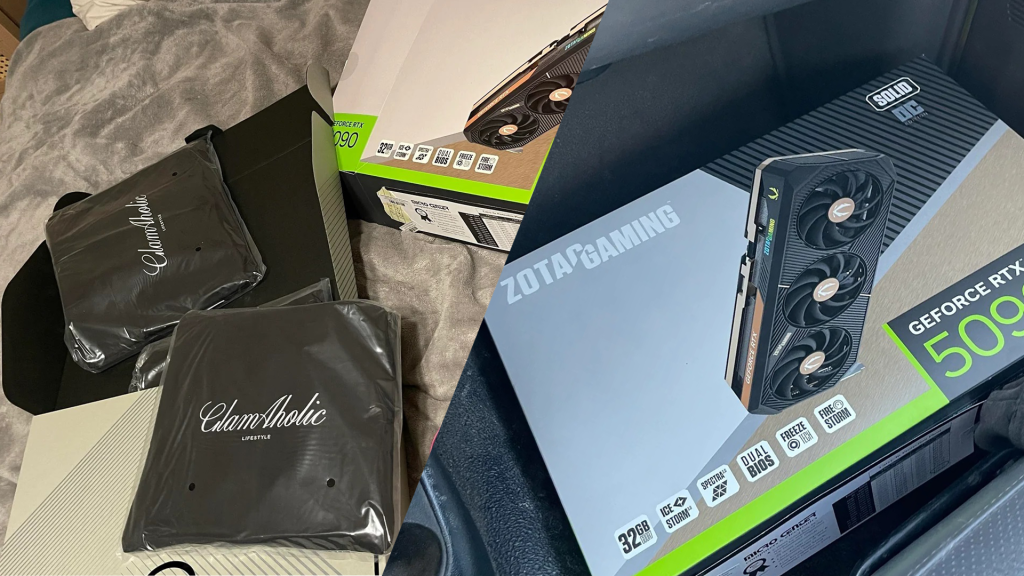
Backpacks instead of GPUs? That’s not exactly what you expect when you unbox a brand-new Zotac GeForce RTX 5090, a graphics card that costs nearly three grand and is supposed to be the crown jewel of any gaming rig. But that’s exactly what happened to a stunned Micro Center customer in Santa Clara, California, when he brought home a sealed box of what should have been cutting-edge silicon—and found it packed with backpacks instead. Yeah, you read that right: backpacks. No GPU. Just bags.
As wild as that sounds, it gets worse. Micro Center’s investigation revealed that this wasn’t an isolated incident. They found 31 more boxes, all factory-sealed Zotac GPU packages, containing the same bizarre swap. That’s a total of 32 units—thirty-two people who thought they were unboxing a top-tier graphics card and instead found themselves holding a backpack like they’d stumbled into a camping store. And these weren’t random, unsealed boxes—these were supposedly fresh, untouched shipments straight from the factory floor.
So, how does something like this even happen? Let’s rewind. The Reddit user who first blew the whistle, JamesFerg650, posted his story, and it spread like wildfire. The original post described the gut-punch feeling of opening the box and realizing there was no RTX 5090 inside, just backpacks. Soon, others chimed in with similar stories, and it became clear this wasn’t a fluke. Micro Center quickly jumped into action, launching an investigation and confirming the pattern: all the affected boxes were Zotac cards, all factory-sealed, all tampered with somewhere along the supply chain.
Think about that for a second. These aren’t your typical returned items or open-box specials. These are supposed to be the real deal, direct from the manufacturer, sealed tight with shrink-wrap and all. The fact that 32 of them were swapped out suggests a much deeper problem than just a shipping error or a rogue employee at one store. This points to a breach somewhere upstream—maybe at the manufacturing plant, maybe at the packaging facility, maybe during shipping. Wherever it happened, it’s a mess, and it’s shaking a lot of people’s trust in the system.
And let’s not forget the sheer value of these cards. The RTX 5090 isn’t just another graphics card. It’s the latest and greatest, the kind of hardware that gamers dream about. At nearly $3,000 a pop, 32 missing units represent almost $100,000 worth of tech. If someone swapped them out deliberately, it wasn’t just for laughs—this was a calculated heist, plain and simple. GPUs have been in high demand for years, and a black-market operation could make a fortune reselling these cards under the table, no questions asked.
Meanwhile, the stolen GPUs themselves haven’t surfaced—at least, not yet. They could be stashed away, waiting for the right moment to hit the secondary market, or maybe they’ve already been quietly sold off in private deals. Either way, it’s a headache for both Micro Center and Zotac. Micro Center has publicly acknowledged the problem and recommended customers open expensive electronics in-store to confirm they’re getting what they paid for. It’s a smart move, but it also feels like a patch over a bigger hole. After all, if the seal on a box can’t be trusted, what does that say about the supply chain?
For Zotac, this is a nightmare scenario. They’ve got a brand to protect, and customers are now second-guessing every purchase. If a factory-sealed box can’t guarantee a product’s authenticity, it throws the whole system into question. This is the kind of breach that makes you wonder how many other incidents might have slipped under the radar. Zotac hasn’t released an official statement yet, but you can bet they’re scrambling behind the scenes, reviewing security protocols, auditing their processes, and trying to figure out how this could have happened.
The whole situation has sparked a broader conversation in the tech community. Should stores open high-ticket items like GPUs at the checkout counter, just to verify the contents? It might feel a bit weird, like a grocery bag check on steroids, but maybe it’s the kind of precaution that’s necessary in today’s market. With so much value packed into a tiny box, it’s no wonder these products are a target for theft and tampering.
For consumers, the lesson is simple: be vigilant. If you’re spending thousands on a GPU, open the box right then and there. Make sure what you paid for is actually inside before you walk out the door. It’s a small inconvenience compared to the gut-wrenching shock of discovering you’ve been scammed.
The Zotac backpack debacle is more than just a funny headline—it’s a wake-up call. It’s a reminder that even in a world of advanced technology and complex logistics, old-fashioned theft and deception can still sneak in and cause chaos. The hope is that this mess prompts companies to tighten up their security, verify shipments more carefully, and rebuild the trust that customers expect when they see a factory seal.
For now, though, the tech world waits to see what Zotac and Micro Center will do next. Will they track down the missing GPUs? Will they compensate affected customers? And most importantly, will this be the last time we see a backpack where a graphics card should be, or is this just the beginning of a much bigger problem lurking in the shadows? Only time will tell, but one thing’s for sure: a factory seal isn’t as ironclad as we thought it was, and the game has changed.


